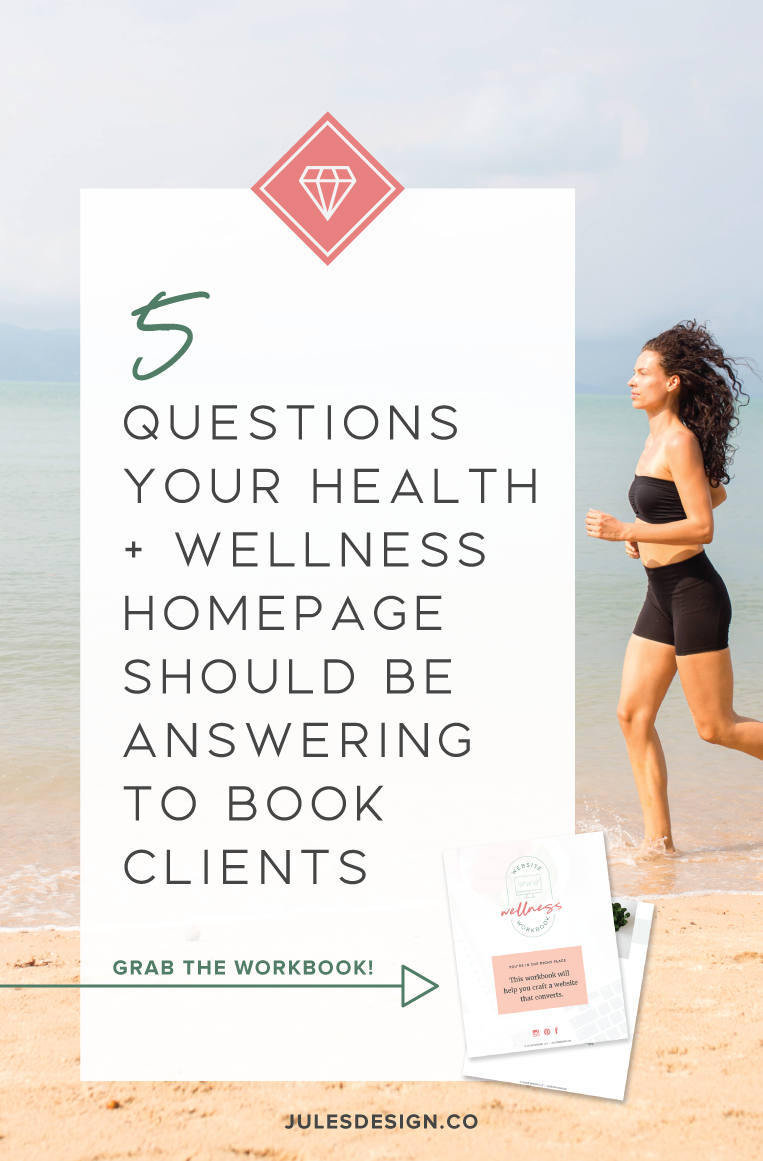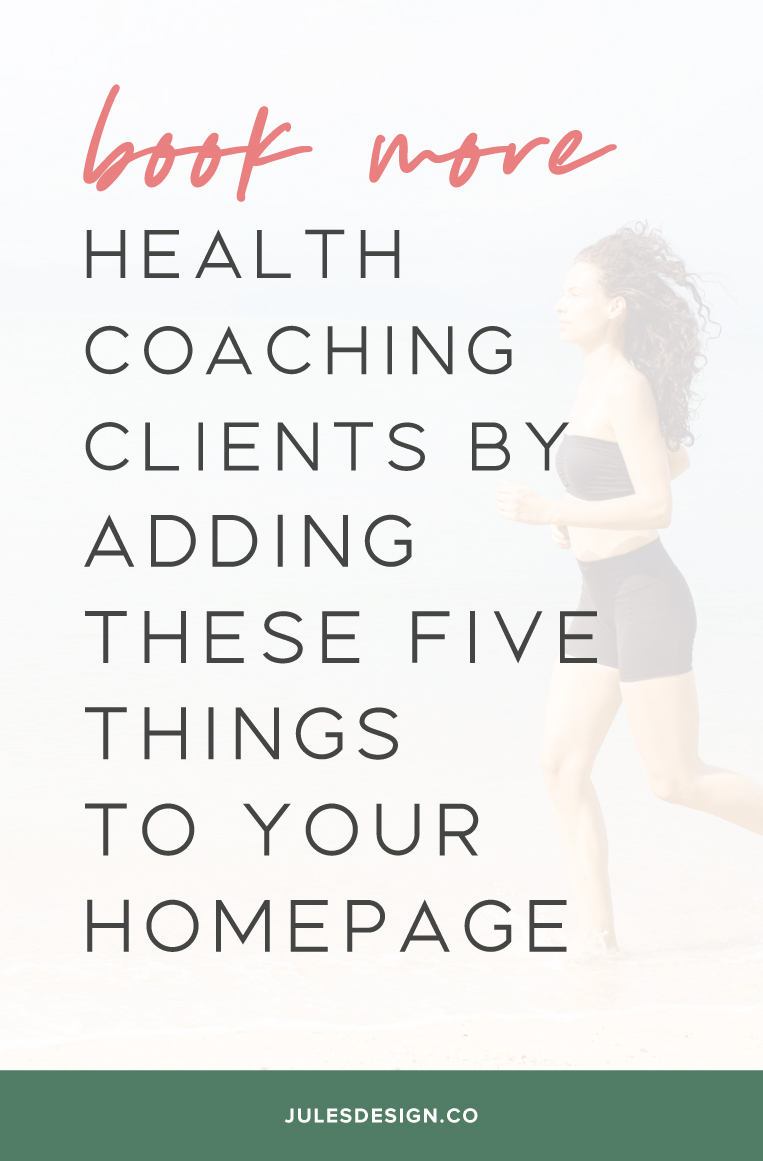 I get it. It’s so tempting to put #allthethings on your homepage. I mean, how do you determine what’s most important when you have all these amazing things to offer your ideal client?
I get it. It’s so tempting to put #allthethings on your homepage. I mean, how do you determine what’s most important when you have all these amazing things to offer your ideal client?
But simplicity is key. We don’t want to overwhelm your potential client with a ton of info first thing on the homepage.
Think of your homepage as an introduction. It’s not a place to hard sell your latest offering or service. It is the place for your ideal client to get to know you and see how you can help them.
When I’m working with a new website design client I like to ask these 5 questions to determine what should go on the homepage and how the design will look.
Who Are You?
Your homepage needs to introduce the world to you. Developing a personal brand is one of the best ways to connect with your audience in the health + wellness industry.
But, this isn’t the place to tell your entire life story. It is the place to have a little bit of information about who you are and why you do what you do. You can even set this section up to link to your About page so that people can get even more info, once you’ve hooked them to read more.
Oh, and before we move onto the next question. You need a photo of yourself on the homepage. There is no better way to build a connection on your website than with a photo or video of yourself. Preferably, above the fold so that people can connect with you immediately.
What Do You Do?
For real though, what do you bring to the table? What is your offering? Introduce your ideal client to this dreamy product or service that you’ve created. Then include links to learn more about it on your Sales or Services page.
Again, this isn’t the place to dive into all the details about what’s included. Quickly summarize what the offering is, who it’s for, and how it will transform an aspect of their lives. This is your chance to entice the reader to learn more.
Who Do You Work With?
You might have noticed that I touched on this question in the last section. But it really deserves its own call out.
This is one of the key questions, I ask my clients when considering what the overall design of their website will be. This is because I make design decisions based on who my client’s target audience is, not what I, or they, think looks nice.
So, who is your niche? Who you are helping? Who do you want to work with?
You need to know your ideal client inside and out to actually get to work with them. Otherwise, it’s impossible to design a website, market your service, or book out your schedule because you aren’t clear on who you’re helping.
On your homepage, you need to clearly state who you work with. And, the design needs to be custom made to attract your ideal client and your ideal client only.
Need some help? If you aren’t sure who your ideal client is, what you want to be known for, or how to market to them then you’ll want to grab a copy of my Wellness Website Workbook to help you create a strategy for success.
How Have You Helped Others?
Now your website user knows who you are, what do you, and who you do it for. If they’re still around then chances are they are your ideal client!
But now, they are wondering where’s the proof? How do I know that this lady I just met on the internet is legit? These are valid questions.
This is where social proof, aka testimonials, comes into play.
You want to include your customer or client testimonials so that your ideal client can connect with them. They should see themselves in those testimonials. Help them understand the transformation and process that these previous clients went through.
The best way to do this is with testimonials that are either story based or results based.
Stories, as in transformation stories from point A to point B. What was this person’s life like before? What’s it like now? Stories should pull on the heartstrings of the reader. The reader will be able to really see themselves in the other person’s experience.
Results based testimonials are measurable. In this case, the client went through a transformation and has the numbers to prove it.
For example, if you’re a personal trainer you could share a client testimonial about weight loss or body recomposition with measurable results. Share the numbers to prove that what you’re selling, actually works.
What Should They Do Next?
Your homepage should have a goal. In fact, your entire website should have goals. But I’ll save that for another day.
Your homepage should be focused on getting users to take a specific action.
If your goal is to make an introduction then you could funnel into another important page, like the About page, Services page, or Sales page.
Or, you could get a little more strategic here and choose to grow your email list or promote a webinar that you’re hosting soon. Your homepage is the perfect place to give away something for free to build that trust up with your ideal client.
Push beyond thinking of your homepage as a simple brochure that gives information. What action can users take to get one step closer to working with you?
And, there you have it! These are actual questions that I have my clients answer before I start working on their website. User experience and strategy are just as important as all the pretty design details when it comes to your brand and website.
I hope that these 5 questions helped you to create an awesome homepage for your health + wellness business. When done right, a homepage can help you build a lasting connection with your ideal client, that eventually leads to them, booking you.
If you aren’t sure who your ideal client is, what you want to be known for, or how to market to them then you’ll want to grab a copy of the Wellness Website Workbook below, to help you create a strategy for success.
Grab Your Copy of the Wellness Website Workbook:


You only get one homepage. Let’s make it work harder. Get a free expert review of your homepage, so it actually attracts your dream clients!
Free Homepage Health Check
Copyright 2022 - All Rights Reserved | Website made by Jules Design (of course!)
Terms & Conditions
Privacy Policy
We are a Richmond Virginia based website design and brand identity design studio for dietitians, nutritionists, health coaches, fitness professionals and wellness entrepreneurs. We love working with brands with compassion in the health space.
